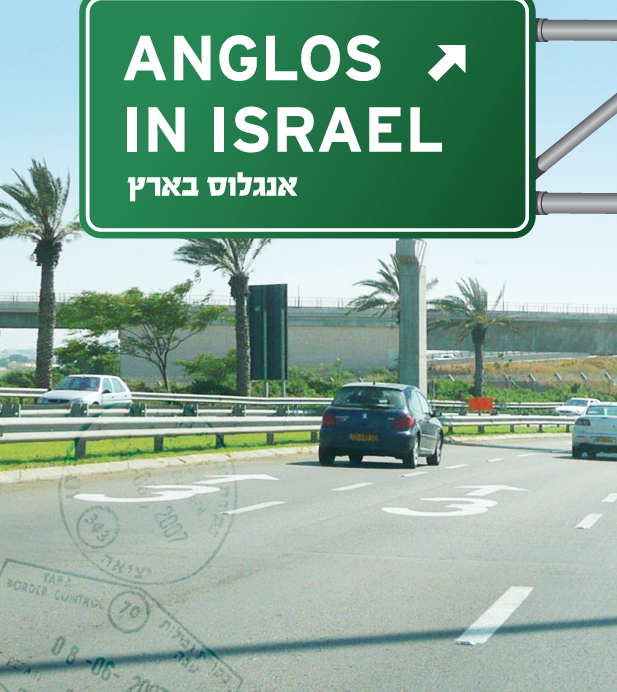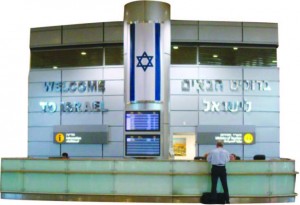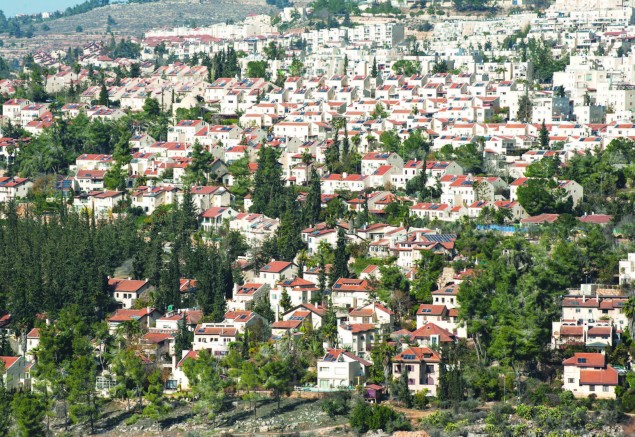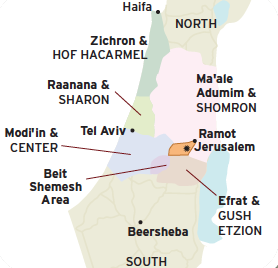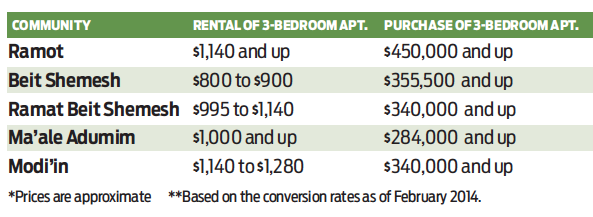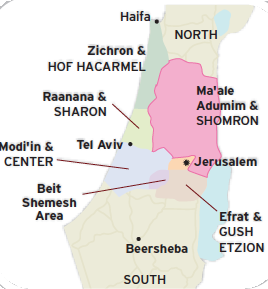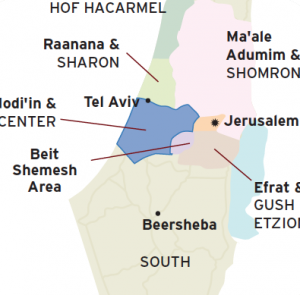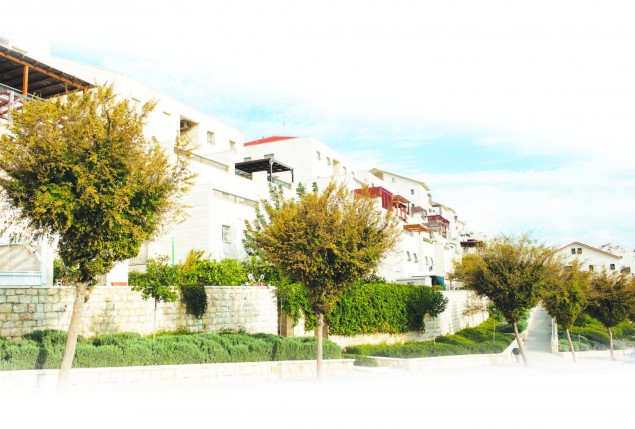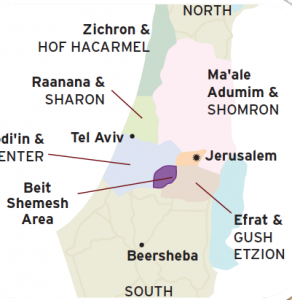Anglos in Israel: Their Lives, Their Communities, Their Influence on Israeli Society
Until recently, any native English speaker living in Israel was considered Anglo-Saxon. That’s “Anglo-Saxim” in Hebrew. That has changed a bit in the past decade. English speakers are now called “Anglos.”
About 200,000 North Americans currently live in Israel, according to the Association of Americans and Canadians in Israel (AACI). Nefesh B’Nefesh (NBN), the umbrella organization for virtually anything related to making aliyah for those from North America and the United Kingdom, estimates that 3,700 olim arrived from North America and the UK in 2013.
Aliyah in the Twenty-First Century
English-speaking olim, according to NBN, are moving to areas stretching from the south of Jerusalem to the north of Tel Aviv. Most singles move to Jerusalem or Tel Aviv. Families are moving to places like Modi’in, Beit Shemesh, Ramat Beit Shemesh, Efrat, Raanana and Ma’ale Adumim. In other words, Anglos tend to move to the center of the country.
According to Marc Rosenberg, director of NBN’s Pre-Aliyah Department, many olim dream of living in Jerusalem but they either find it too expensive or can’t find jobs, so they move elsewhere. Approximately 30 percent of Anglo olim move to the north and the south of Israel. Popular communities in the north include Karmiel, Nahariya, Ma’alot, Safed and Haifa; in the south, common choices are Be’er Sheva, Ashkelon and kibbutzim in the Arava.
When it comes to choosing a specific community, olim often have preconceived notions. “People have told me they are looking for a ‘YU community’ or a ‘Chareidi community,’” Rosenberg says. “Just because potential olim might look for a certain type of community in America, that doesn’t mean that that is the right choice for them in Israel. It’s different here.”
Why would a family making aliyah move to an English-speaking community? In a word: comfort. In the past, olim have always talked about integration and acculturation as their goals; “becoming Israeli” was their mantra. Is this still true for those making aliyah in the twenty-first century?
Choosing where to live when one makes aliyah is very personal and includes multiple factors such as proximity to friends, job opportunities and financial realities, says Rabbi Avi Berman, executive director of the Seymour J. Abrams OU Israel Center.
“When I look at the experiences of friends who moved to Israel when my family came in the mid-1980s, those who had the most successful transitions were those who chose to live in predominately Hebrew-speaking communities,” says Rabbi Berman. “They learned to swim by jumping right into the deep water.
“Israeli society is based on networking and in order to ‘make it’ you’re better off networking with Israelis,” he says. “Israelis have obviously been here longer, they know the system better and they speak Hebrew, which is one of the most important factors if you plan to live in Israel.
“Having said that,” Rabbi Berman continues, “the mitzvah of yishuv ha’aretz, settling the land, is what it’s all about. I respect every person or family who leaves any community anywhere in the world to come to Israel,” he says, “no matter where [in Israel] they ultimately choose to live.”
Not the Same Aliyah Experience
What makes aliyah different today compared to aliyah in the 1970s or 1980s? There are two main differences: the Internet and NBN.
In previous generations, new immigrants were housed in absorption centers. Operated by The Jewish Agency for Israel, they included relatively small apartments, but new immigrants were given access to social workers to help them adjust and to an ulpan where they learned Hebrew. Most important, they knew they had a home when they arrived.
Especially for Western olim, absorption centers were never intended to be their permanent homes. They were temporary solutions until olim decided where they wanted to live and found work for themselves and schools for their children.
All that has changed.
“The effect of the Internet is that olim today experience what we call a ‘soft landing,’” Rosenberg says. “Very few North American families go to absorption centers anymore. They get information about schools and communities before they come.”
Thanks to NBN, the aliyah process is more streamlined today than ever before. Prospective olim do a lot of research on the Internet and then generally go on a pilot trip where they visit one or two communities, find an apartment and register their children for school. In previous generations, olim made all their arrangements after they arrived.
Today’s olim have access to more research, which results in a different type of experience. “Nefesh B’Nefesh tries to provide them with as much pre-aliyah information as possible,” Rosenberg says.
Following are stories about religious North Americans who made aliyah—some decades ago, others more recently—the communities in which they live and the lives they have made for themselves in Eretz Yisrael.
*All aliyah-related statistics provided by Nefesh B’Nefesh.
Ramot
Driving from Tel Aviv to Jerusalem, just before reaching the entrance to the capital, if you look to the left (north) you see one of Jerusalem’s last open green spaces. The green ends with homes that are distinguished by their red-tile roofs. This is the suburb of Ramot Alon, better known as Ramot. The name Ramot is based on the Biblical city of Rama, where Shmuel the Prophet lived.
The first homes in Ramot were built in the early 1970s, and today the area boasts an estimated 70,000 residents. The modern suburb is built on two ridges with Golda Meir Boulevard in the middle. “Golda,” as the highway is referred to in Hebrew, heads west toward Givat Ze’ev and Tel Aviv.
Jerusalem’s Har Hotzvim high-tech area is close by, providing plenty of employment opportunities. This is the home of a host of start-ups, as well as more developed companies including Intel, Teva, Amdocs and others.
What makes Ramot attractive? As its name—which means “heights”—implies, it offers beautiful views. For the past few decades, residents have been taking advantage of the suburban location to build larger homes with more open space than is possible in the city. Today, there is a mix of single-family private homes, town houses, apartments, subsidized housing and assisted living for the elderly, including immigrants from the former Soviet Union and Ethiopia. Due to its proximity to downtown Jerusalem, Ramot has long been an attractive choice for Anglos.
However, these days only a small number of religious Anglo olim are moving to Ramot. Most choose to move into newer, smaller and more affordable apartments in communities a bit farther away from Jerusalem.
In 2011, Ramot Mall opened with about fifty stores. The mall is closed on Shabbat, as are almost all malls in Israel. All the food is kosher, predominately mehadrin.
About 65 to 70 percent of NBN families are Orthodox.
While Ramot has strong Dati Leumi and Chareidi communities, it includes a wide variety of residents across the religious spectrum. Synagogues and schools reflect this diversity.
Where do religious English speakers fit into this suburban mosaic? NBN estimates the number of English speakers in Ramot at about 20 percent.
“Perception of whether a city or town has a lot of English speakers is important,” Rosenberg says. “The fact is that a total of 20 percent English speakers in a suburb or a small city is a significant number of people.” Communities like Ramot and Efrat are cases in point. Israelis comment on how much English they hear while walking down the street in both locations.
“Your Friends Become Your Family”
Evy Gottlieb, who made aliyah in the mid-1980s, and Karen Kirschenbaum, who came right after high school in the mid-1970s, are in their fifties. They both grew up in the Riverdale section of the Bronx in New York, and while their families got together occasionally, the two women were not friends.
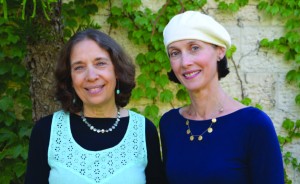
Evy Gottlieb (left) and Karen Kirschenbaum are neighbors in Ramot Bet and consider each other “sisters.” Photo: Zvi Volk
That was then. Today they are neighbors who bought homes in Ramot Bet several decades ago. They weren’t aware that they were going to be neighbors. “But . . . we are walking through life together,” says Gottlieb. “We brought up our children together. We’re like sisters and our children are friends.
“When you make aliyah without family, your friends become your family,” continues Gottlieb, who is a psychotherapist. “I don’t have any close family here and neither do a lot of my friends. We support each other.”
Top Five Anglo Dati Leumi Communities
Jerusalem
Ramat Beit Shemesh
Modi’in
Raanana
Beit Shemesh
Kirschenbaum, who has a PhD in Talmud from Bar-Ilan University, teaches at several Jerusalem midrashot. While many of her friends are English speakers, she prefers teaching in Hebrew and she doesn’t speak English to any of her children or grandchildren.
“Because my husband is Israeli, I probably didn’t feel so Anglo,” Kirschenbaum says. “The most difficult times for me were when he was in miluim [IDF reserves] and I was at home with six children. I had to depend on my friends for support.”
“Now that my parents are older, I often think, ‘chaval [too bad] that my family doesn’t live here,’” Gottlieb says. “But I never think, ‘chaval that I don’t live there.’”
Ma’ale Adumim
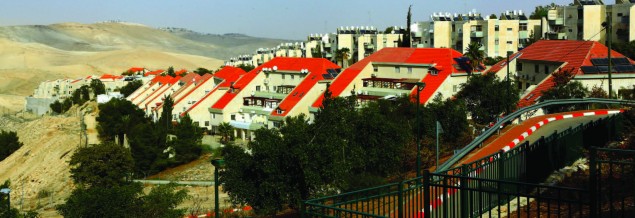
Mitzpe Nevo, a vibrant, friendly Dati Leumi community, is built on cliffs overlooking the Judean Desert, Jerusalem Hills, Mt. Scopus and Har HaZeitim. Photo: Sasson Tiram
The best view of Ma’ale Adumim is from the eastern edge of The Hebrew University campus on Mt. Scopus. Looking out at the desert on a clear day you can see a lovely suburb a few miles away. When the weather is exceptionally clear, you can also get a glimpse of the Dead Sea.
The road from Mt. Scopus to Ma’ale Adumim goes from Jerusalem straight into the desert. In fact, Ma’ale Adumim, twenty minutes from downtown Jerusalem, is surrounded on all sides by the Judean Desert. Around every corner you are treated to dramatic desert panoramas.
The name Ma’ale Adumim, which means “Red Ascent,” refers to the red rocks that are visible when traveling up from the Dead Sea toward Jerusalem.
Today, Ma’ale Adumim, which was founded after the Yom Kippur War in 1975, has a population of about 40,000. With its clean palm tree-lined streets, the city offers a high quality of life. It has an enclosed shopping mall, parks and sports and recreational centers as well as a variety of educational and religious institutions. There are more than forty Ashkenazic and Sepharadic synagogues throughout the city, a leading hesder yeshivah, Yeshivat Birkat Moshe and a kollel. The population is reflective of Israel as a whole. This includes the complete spectrum from nonreligious to Chareidi. There is also a healthy mix of new immigrants and native-born Israelis.
Mitzpe Nevo, one of the northernmost neighborhoods in Ma’ale Adumim, is built on cliffs overlooking the Judean Desert, Jerusalem Hills, Mt. Scopus and Har HaZeitim. Most of the houses in the neighborhood cling to the hillside. About ten years ago, construction started on an addition to the neighborhood consisting of mostly private homes.
Yeshivat Birkat Moshe is located in Mitzpe Nevo, which is a vibrant, friendly Dati Leumi community. According to NBN, about 40 percent of the community is English speaking. This qualifies as a very large English-speaking community.
What brings residents to Mitzpe Nevo?
When Nachum Schnitzer was studying for semichah at Yeshiva University’s Rabbi Isaac Elchanan Theological Seminary (RIETS) in the late 1970s, he once heard Rabbi Nachum Rabinowitz, rosh yeshivah of Yeshivat Birkat Moshe, tell students, “You should come and live in Mitzpe Nevo.” He remembers thinking, “Why would I want to live in the desert?” he says.
Then he and his wife, Bracha, made aliyah with their young family. As most olim did back then, they started off in an absorption center in East Talpiot, a neighborhood in Jerusalem, for a year and a half.
“We decided to live in Mitzpe Nevo because we could get a decent-size house for less money than had we stayed in Jerusalem,” says Bracha, who has a BA from Stern College and an MA from NYU. Back then, the roads were in poor condition so Mitzpe Nevo was considered “far” from Jerusalem. Today this is no longer the case.
Top Five Anglo Yishuvim
Efrat
Neve Daniel
Chashmonaim
Yad Binyamin
Alon Shvut
“Now that we live in the desert, I realize that we really are living the connection between the mekorot [Torah sources] and our land,” Nachum says. “This is the landscape that Eliyahu HaNavi saw. The emptiness is awe-inspiring. It’s like a prayer that is waiting to be fulfilled.
“When you’re in Jerusalem, you are reminded every day that you’re in the center of the Jewish world,” Nachum says. “The Temple Mount has a presence that just can’t be ignored. You know you’re walking in the footsteps of prophets and kings.
“But the Biblical connection is not always so evident when you’re outside of Jerusalem. The connection you feel when you live on the edge of the desert is more subtle, more nuanced.”
While the Schnitzers were not necessarily seeking only Anglo friends, their closest friends all happen to be English-speaking. This includes their next-door neighbors, Yitzhak and Bracha Zuriel.
Of the 3,700 Anglo olim who arrived in Israel in 2013, 39 percent were single.
The Zuriels chose to live in Mitzpe Nevo because it was outside of Jerusalem and “still under construction, so the prices were lower,” says Yitzhak, who has a BS from MIT and works for a high-tech company in Jerusalem. Choosing Mitzpe Nevo enabled them to buy a home that was large enough to accommodate their growing family.
“We never spoke Hebrew [to the kids],” Yitzhak says. “We knew they would learn Hebrew from the neighborhood and in school. Being bilingual is our gift to them.
“I think we are pretty well acculturated so that my native language doesn’t define me,” he says. “By and large, people who moved here in the mid-1980s thought it was important to integrate with Hebrew speakers.
“But as I get older, I find that I read and listen better in English,” says Yitzhak, who is in his late fifties and has nine grandchildren. If his extended family of twenty is sitting around the Shabbat table, he finds it easier to listen to English. “There are times when the effort required to listen to Hebrew wears me out,” he admits.
Modi’in
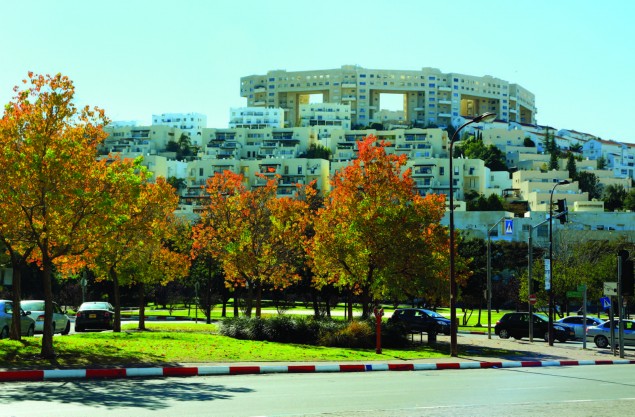
Modi’in is a modern city that was planned by the world-renowned architect Moshe Safdie. An environmentally friendly city, it boasts wide streets, a covered shopping mall and direct train service to Tel Aviv. Photo: Sasson Tiram
In ancient times, Modi’in was the home of the Hasmoneans who were among the leaders of the revolt against the Greeks during the period of the Second Temple. The Maccabees lived in this area.
The cornerstone for the modern city of Modi’in was laid in the 1990s. Over the years, the city, located twenty-two miles southeast of Tel Aviv and twenty-one miles west of Jerusalem, has become home to more than 80,000 people.
Modi’in is a modern city that was planned by the world-renowned architect Moshe Safdie. An environmentally friendly city, it boasts wide streets, a covered shopping mall and direct train service to Tel Aviv. Unlike cities that simply grew over the past few decades, Modi’in is a well-planned city. It offers lots of green open spaces—occupying half of the area within the city limits—including a large park with an artificial lake.
Originally planned as a secular city, Modi’in has a religiously diverse and cosmopolitan population. While many religious olim feel comfortable in Modi’in, they are definitely in the minority.
By and large, the residents are attracted to Modi’in’s urban mix and aesthetically pleasing environment. Many—but not all—of the English-speaking residents (about 20 percent of the city’s total population) are Orthodox professionals who have the option of working close to home or making the easy commute to either Tel Aviv or Jerusalem. It is not uncommon for spouses to work in different cities.
Aliyah on Impulse
Elliott Cahan, forty-six, and his wife, Ilene, made aliyah in 2004 from Baltimore. Elliot was a nursing home administrator for about twelve years in the US. “We made aliyah almost on impulse,” he admits. “We came on faith and hoped for the best.”
He worked at a variety of jobs for about three years before becoming COO of a Jerusalem yeshivah with a large program for students from abroad. The Cahans have three children, ages thirteen to twenty-one, all of whom were born in America.
“All of our friends and our children’s friends are English speaking,” Elliot says. “That’s whom we’re comfortable with.”
They all faced a myriad of challenges when they moved to Modi’in, he says. “The bottom line is that we had to learn a whole new set of rules.”
Beit Shemesh
There are two towns midway between Tel Aviv and Jerusalem that many English speakers now call home: Modi’in and Beit Shemesh, particularly Ramat Beit Shemesh Aleph and Sheinfeld. Ramat Beit Shemesh Aleph is home to many religiously right-of-center families while Sheinfeld attracts a predominantly centrist population.
Native-born Israelis often claim that all “Anglos” speak Hebrew with an American accent—even if the speaker actually grew up in Auckland, Johannesburg or Manchester. The late Prime Minister Golda Meir, who grew up in Milwaukee, spoke Hebrew with a very pronounced Midwestern accent. But most sabras can’t tell the difference between a Midwestern and a Brooklyn accent.
Both Modi’in and Beit Shemesh are on the NBN list of most popular destinations for new olim from North America.
The roots of the town of Beit Shemesh date back to Biblical times. Beit Shemesh is mentioned in the Book of Joshua as being on the border between the tribes of Judah and Dan.
“We’ve been seeing more and more secular singles make aliyah in recent years as a result of Birthright.” —Nefesh B’Nefesh spokesperson
Within a decade after Israel’s War of Independence, Beit Shemesh became the prototypical development town, with a population that came mainly from North Africa. Located about a thirty-five-minute drive from Jerusalem and a forty-minute drive from Tel Aviv, Beit Shemesh is today well served by buses and train lines, and most of the residents commute to work in Jerusalem or Tel Aviv.
Newer areas in Beit Shemesh including Sheinfeld and all the various Ramat Beit Shemesh neighborhoods, are almost completely dati, with synagogues of every stripe and flavor. Today, Chareidim comprise nearly half of the population of Beit Shemesh,1 including Chassidic communities such as Ger, Belz, Satmar and Neturei Karta.
In February 2012, Haaretz reported that in the 2012-2013 school year, 75 percent of the children entering first grade in Beit Shemesh were expected to be Chareidi.2
This population shift has led to unfortunate confrontations and tensions within the city, leading up to the recent invalidation of the mayoral election. However, little of this is reflected in daily life, and for the most part the various communities coexist harmoniously and enjoy the many advantages Beit Shemesh has to offer.
Top Five Anglo Chareidi Communities
Jerusalem
Ramat Beit Shemesh
Beitar Illit
Ashdod
Bnei Brak
It was in the early 1990s that the Kiryat Aryeh Sheinfeld neighborhood started becoming popular with Orthodox English-speaking olim. Some of the reasons for its growing popularity were the same reasons the Schnitzers and the Zuriels were attracted to Mitzpe Nevo some decades earlier: it is outside of Jerusalem and was just being developed and therefore less expensive.
But the families choosing to live in Sheinfeld today are drawn to the area not only because of its affordable housing; they are looking for an active English-speaking community that offers the religious and social equivalent of the Modern Orthodox communities they have left behind in the Diaspora. Conversation in the streets, stores and shuls is largely conducted in English, although all the announcements in the shuls and almost all of the shiurim are in Hebrew. The children grow up bilingual, speaking English at home—and often also with their friends—and Hebrew at school.
No Place Like Home
Jeff and Elyssa Aftel made aliyah in 2005 and chose to settle in Sheinfeld. (Elyssa is Elliott Cahan’s sister.) The Aftels have six children, ages four to twenty-one. Their youngest was born in Israel.
“We chose Sheinfeld because of the schools, the shuls and our rabbi,” says Jeff. Like many Anglos, Elyssa, forty-four, says she and her husband preferred to live among people who could relate to the huge adjustments they had to make. “It’s still a challenge for me to speak Hebrew, but I do it,” she says.
“I came to Israel without a job,” says Jeff, forty-five, who has semichah from RIETS and a degree in computers from YU. He worked in Jewish education in the US. “I wanted to stay in education, but we couldn’t afford it,” he says. He took a course in technical writing and found a job quickly. He has been working for a major international computer hardware company for the past six years.
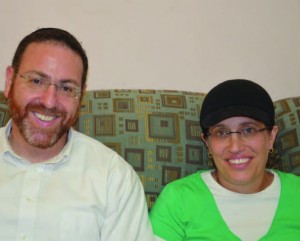
Jeff and Elyssa Aftel made aliyah in 2005 to Bet Shemesh. They have six children, ages four to twenty-one. Photo: Zvi Volk
“When we first came,” he says, “we were uncomfortable about a lot of things. But with time, life becomes less frustrating.
“Our kids are light years ahead [in their Jewish education] compared to where they would be in America,” Jeff says. “That’s because their Hebrew is so much better. Language is such an important component of education. When you combine [proficiency in] Hebrew with the strong emphasis on Torah education that exists here, you end up with children who have a much deeper understanding and mastery of Torah text.”
Elyssa adds, “What’s most important is that as Torah-observant Jews, there is no place for us to live other than Eretz Yisrael.”
Notes
1. Harriet Sherwood, “The battle of Bet Shemesh,” The Guardian, October 31, 2011, accessed January 10, 2014, www.theguardian.com/commentisfree/2011/oct/31/bet-shemesh-haredi-jews-school?newsfeed=true.
2. Yair Ettinger, “Three quarters of Beit Shemesh first-graders will attend ultra-Orthodox schools next year,” Haaretz, February 8, 2012, accessed January 10, 2014, www.haaretz.com/news/national/three-quarters-of-beit-shemesh-first-graders-will-attend-ultra-orthodox-schools-next-year-1.411748

